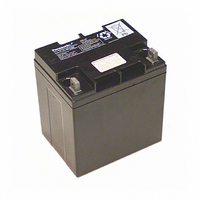LC-X1228P Panasonic - BSG, LC-X1228P Datasheet - Page 21

LC-X1228P
Manufacturer Part Number
LC-X1228P
Description
BATT SEALED LEAD ACID 12V 28AH
Manufacturer
Panasonic - BSG
Series
LCr
Datasheet
1.LC-X1228AP.pdf
(67 pages)
Specifications of LC-X1228P
Voltage - Rated
12V
Capacity
28Ah
Size / Dimension
6.47" L x 4.92" W x 6.89" H (165mm x 125mm x 175mm)
Termination Style
Nut/Bolt, M5
Rechargeability
Yes
Weight
25 lbs (11.3kg)
For Use With
BVW122250003N - BATTERY CHG UNIV 12VDC @ 2.25A271-2390 - BATTERY CHG UNIV 12VDC @ 2.25A271-2386 - BATTERY CHG UNIV 12VDC @ 1.2A271-2385 - BATTERY CHG UNIV 12VDC @ 600MA271-2382 - BATTERY CHG UNIV 12VDC @ 500MA271-2381 - BATTERY CHG UNIV 12VDC @ 500MA271-2380 - BATTERY CHG 120VAC 12VDC @ 500MA271-2378 - BATTERY CHG 120VAC 12VDC @ 300MAPATC-08 - BATT CHARGER 12V 1.5A X 2 UNITPATC-03 - BATTERY CHARGER 12 VOLT 1.5 AMP
Lead Free Status / RoHS Status
Contains lead / RoHS compliant by exemption
Other names
LC-X1228
LC-XB1228
LC-XB1228P
LCX1228P
P049
LC-XB1228
LC-XB1228P
LCX1228P
P049
CHARGING METHODS
Methods of Charging the Valve-Regulated Lead-Acid Battery
For charging the valve-regulated lead-acid battery, a
well-matched charger should be used because the
capacity or life of the battery is influenced by ambient
temperature, charge voltage and other parameters.
(1) Main Power (Cycle use)
Cycle use is to use the battery by repeated charging
and discharging in turn.
(a) Constant voltage charging method
Classification
by application
This method is to charge the battery by applying a
constant voltage between the terminals. When
the battery is charged by applying a voltage of
2.45 V per cell (unit battery) at a room
temperature of 20°C to 25°C, charging is
complete when the charge current continues to
be stable for three hours. Valve-Regulated lead-
acid batteries can be overcharged without
constant voltage control. When the battery is
overcharged, the water in the electrolyte is
decomposed by electrolysis to generate more
oxygen gas than what can be absorbed by the
negative electrode. The electrolyte is changed to
oxygen gas and hydrogen gas, and lost from the
battery system. As the quantity of electrolyte is
reduced, the chemical reactions of charge and
discharge become inefficient and hence the
battery performance is severely deteriorated.
Therefore, exact voltage control and proper
charging time in constant voltage charging are
essential for securing the expected life of the
battery.
(2) Stand-by power source
(1) Main power source
(Cycle use)
VRLA BATTERIES PAGE 20
Charging methods are dependent on battery
applications, and the applications are roughly
classified into main power application and stand-by/
back-up power applications.
(b) Constant-voltage and constant-current
Constant-voltage constant-current charge characteristics
charging method
This method charges the battery by controlling the
current at 0.4 CA and controlling the voltage at
2.45V/per cell (unit battery) at a room temperature
of 20°C to 25°C. Proper charging time is 6 to 12
hours depending on discharge rate.
~ ~
0
(a) Constant Voltage
(b) Constant Voltage/Constant Current
(a) Two-step constant voltage
(b) Compensating charge (Trickle/float)
1
2
3
Charge current
Charge voltage
4
5
AUGUST 2003
Time (hours)
6






















